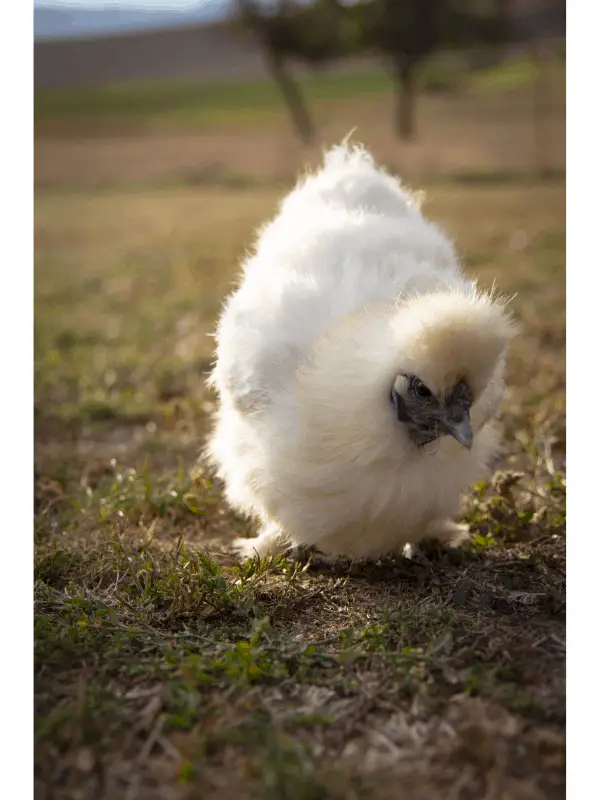Whether it is the neighborhood lurker or your own pet cats, preventing a catastrophe (pun intended), is much easier than drying off tears later on.
Silkie chickens are bantams meaning they are much smaller than the average house cat. This can make them vulnerable to attacks by cats. Silkies can not fly and have poor vision. If they are kept in an area where cats roam, they need to be protected in a secure coop.
There are a good few instances where silkies and cats can live happily ever after, but more common than not, the relationship can be rather unpredictable, especially if you live in a neighborhood with many free-roaming cats.

Nine Lives vs. One
The most common cause for backyard silkie fatalities is roaming domestic cats. Second to that are other wild animals such as foxes, hawks, weasels, and opossums. Silkies are extremely easy targets. They can not see very well due to their fluffy crests often obstructing their view. In addition to that, they can’t fly and most of them are very docile. Very few silkies will put up a fight when confronted by a predator.
Silkie chicks and even up to layer age (around 7 – 9 months) must be protected against predators. Silkies up to this age are rather naive and may not necessarily realize the danger of a stalking cat. Not to mention, they are small and can easily be attacked by a cat.
Getting silkies and cats to live happily together may require a few modifications to your setup. Training and patience can also go a long way when it comes to your own house cats. We have a look at what you can do to keep your silkies safe from felines on the prowl.
Seeing through the eye of the (common, domesticated, miniature) tiger
Cats are hunters. Not always killers, but definitely hunters by natural instinct. If something cowers and tries to get away, a cat will chase it. That is just their default factory setting. Not all cats hunt for food but almost all cats will hunt simply for the act of hunting.
If you do not already own cats yourself, I am sure you must have heard of or know of a friend whose cat likes to bring offerings of killed small animals to their owners. Cats pay little attention to the disparage of their owners toward their offerings and will often bring small prey inside the home on a regular basis.
Cat’s personalities can differ dramatically. Some cats will be more than happy sun-basking all day, not to be bothered by small fluffy peasants. It helps when you are acquainted with the feline in question and have an idea of what their individual appetite for hunting is.
Seeing from under the Silkie’s fluffy crest
Silkies are known for their exquisite dress code and headgear. The extravagant headgear just tends to get in the way of their vision. If you are not planning to show your silkies, you will do them a mighty big favor to trim their crests so they can have a better view of the world. They will be able to spot a stalking cat much easier.

Keeping silkies safe from the family cat
There are a few practical things you can do to maintain peace and harmony between feather and fur in your household.
Please note that there may be exceptions. Some cats are tigers at heart and no matter the amount of training and precautions that are taken, they will still be dreaming of the day they will be able to take down a silkie. But be patient, give them time, your cat might just surprise you in a good way!
1. Let them grow up together
This would be the ideal situation. If you already have an adult cat and are planning to get silkies or already have a few, you can skip this step.
Kittens from about six weeks old are still very much learning how to be a cat. If they grow up alongside silkie chicks, they will consider them part of the household and will be much less likely to try to hunt them in their lifetime. This will also give the silkie chicks time to get used to cats being around.
Observe playtime and teach the kitten to play with toys and not the silkies. If it attempts to play with the silkies, having a small spray bottle to spray them when they attempt to play with a silkie will quickly teach them to rather avoid the silkies.
Even though this is the easiest and most foolproof method to get the chickens and cats to get along, this will still require a lot of time spent supervising interaction. Especially beware of 4 to 6-month-old kittens who can be especially mischievous in their ‘teenage’ years.
2. Use slow phased-in introduction for adult cats
Once you have a coop or caged run set up for your silkies, you can let your cat have a good look around. Cats are extremely curious and will most certainly come to investigate if there is something new in the yard. Keeping them away may just spike their curiosity even more.
Observe your cat’s reaction at this stage. Does he seem intensely interested in the silkies? does he creep up on them, crouch motionless, or stare at them intently? If so, your cat will probably need a lot of time getting used to the silkies to hopefully, eventually accepting them.
You can use toys to distract your cat and play with him/her near the silkies. This will help the silkies get used to the cat as well. Continue this for a good few weeks until both species seem comfortable around each other.
The next step is to introduce them face to face. Adult silkies will be better suited for this. Gently hold the silkie near your cat. If the silkie seems spooked or if the cat is overly interested in the chicken, go back to the previous step for a few more weeks.
If both species are calm at this stage, you can start allowing the silkie to walk around while the cat is around. Stay in close proximity. this is a good opportunity to keep the spray bottle close by and spray the cat if he becomes overly playful with the silkies or attempts to stalk them.
If your cat seems unphased by the silkies, great! You can start slowly moving away, but still observing. Be a helicopter mom and be nearby when the two species are allowed to free-range in the backyard at the same time. Ideally, the cat should not know that you are nearby. When your cat starts showing any signs of predatory instinct at this stage, go back to having your silkies locked up in their enclosure and monitoring them.
By this time, if you are confident that your cat is not showing any interest in your flock and seems more interested in sunbathing or toys, you can leave them unsupervised for small periods of time.
I would still err on the side of caution, and be around when your silkies are free-ranging while your cat is outside, just throwing a watchful eye every now and then.
It may happen that no matter what you do, your cat will never look at the silkies other than them being prey, and unsupervised free-ranging and even free-ranging at all will be off the cards for them. Be patient and keep in mind that this process may take many months. You will have a good idea of what your cat’s personality is like. If he/she showed some progress in the previous steps, chances are that with a whole lot of patience you might be able to win them over to the silkie-loving side.
3. Keep your cat indoors only
Keeping your cat indoors has many benefits in terms of preventing disease and injuries. Diseases such as the Feline leukemia Virus and Feline Immunodeficiency Virus are transmitted between cats often via bite wounds. Cats that roam large territories and carry the virus(es) transmit it via contact with other cats. Common cat wounds such as cat bite abscesses, lacerations, or hit by car injuries can all be avoided by keeping a cat indoors. The diseases I mentioned here are just the tip of the iceberg and the diseases in question can vary tremendously depending on where you live.
If your cat has been a mostly outdoor cat for most of its life, the sudden transition to being an indoor-only cat will not be advisable as it will cause tremendous stress to your cat. If your cat is still young or spends most of its time indoors anyway, the transition can easily be made.
This is a surefire way to protect your silkies against at least your own cat.

Keeping the silkie chickens safe from the neighborhood alley cat
Free-roaming cats are a lot more difficult to control. Most neighborhoods will have at least a few stray cats that wander around. Cats will often explore their territory during the night time so we often are not that aware of the neighborhood alley cats. One study found that a feral male cat’s territory can be as large as 547 hectares or 1 351 acres.
1. Build a secure coop with a secure run attached

While you are at it, make sure your run is secure against more than the domestic house cat. If you are going to invest in a secure coop and run, make sure there is no way that a predator will be able to dig under the fencing (burry the fencing well below ground level). You can bury a hardware cloth up to two feet around the outside periphery to discourage digging predators such as skunk, fox, badger, or coyote (depending on where you live).
Make sure there are no small openings where snakes and rats can enter. Use secure locks. The general rule of thumb is that if a three-year-old can figure out the lock, a raccoon can too.
Place a roof and use thick mesh wire fencing with openings small enough to keep rats and snakes outside. You can even go as far as to place electric fencing around your coop.
If it keeps all the other predators but, it will definitely keep the cat out. There are many great examples of the secure coop and run designs on the internet. If you want an example of a good secure coop and run, I like this one by New Life on a Homestead. It is very large but can be modified to the size of your flock.
At the very least, I strongly advise that you keep your silkies locked in a secure cook at night as this is often when most predators are on the sprawl.
2. Get a larger flock
A larger flock is less likely to be stalked by a cat. It also means that there are more eyes to be on the lookout for predators.
Having a few larger breed chickens mixed in will also be beneficial. Cats will not likely attack large breed full-grown chickens and they will often help protect the smaller members of the flock and make alarm when there is danger. A breed such as the Barred Rock, Ameracauna, and the Rhode Island Red are all good options.
3. Lock them up at night
At the very least, silkies should be kept in a secure coop during the night when most predators are active. Do not wait for them to go in the coop themselves and call them in before dusk.
As mentioned before, this is a fundamental step in keeping your silkies safe against not only cats but all the predators that lurk after sunset.
Enjoy your pets!

In the end, enjoy silkies and cats for what each species has to offer. Cats will be cats and have their own unique likes and dislikes. Silkies bring happiness and have their own unique requirements as well. If you have a good understanding of each species and the patience to figure out how to have them live in harmony, you will have many years of happy memories thanks to your pets.
